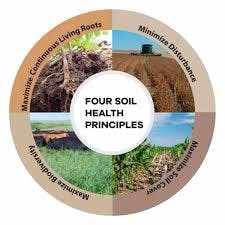Soil

Soil is an incredibly important natural resource. Healthy soil provides for plant production, nutrient cycling, carbon sequestration, and water filtration and storage among other benefits.
Healthy soils have a mix of physical, chemical, and biological components, the composition of which varies across different soil types. Some soils are able to support a wider variety of activities, while others are more restricted. In Jackson County, our Class I and II soils, prime farmland and most widely usable soils, are predominantly on the west side of Bear Creek.
Challenges to Soil Health
Challenges to soil health arise from the way we use and manage soil. Intensive land management uses that expose large amounts of bare ground such as during certain types of construction, timber harvest, crop production, and animal grazing can increase soil erosion via wind and water; erosion is further accelerated on sloped land and from certain irrigation management practices. Soil erosion most critically impacts the uppermost soil layer, the topsoil, the layer most vital for plant growth. In addition to impacting soil health, soil erosion may also impact water quality.
In addition to erosion, leaving soil barren can result in negative impacts to the physical, chemical, and biological properties of soil and its functions: reducing living organisms, soil structure and porosity, and water storage and filtration capacity. Soil disturbance and compaction can also result in these negative impacts. Intensive development in urban areas may lead to changes in overall soil type and structure. Depending on the degree of impact, improperly managed soils may become very limited in their uses.
Management practices for soil health

Minimizing barren soil, disturbance, compaction, and erosion are key to helping maintain healthy soils. In agricultural lands this can look like using no-till or minimal tillage for planting. Planting cover crops on resting fields is a great way to reduce barren soil and protect from erosion while also actively increasing aspects of soil health such as soil structure and nutrient availability. Implementing effective pasture management practices and irrigation management practices are other critical aspects of maintaining healthy soil in agriculture.
In forest lands selective harvest can reduce the amount of soil left barren after harvest; reducing harvest on steep slopes and limiting off-road machine travel can also help reduce soil disturbance, compaction, and erosion. Across land uses, the use of vegetation buffers between barren land and waterways, particularly along steep slopes, can reduce erosion impacts on water quality and allow eroded soil to accumulate on the land surface.
There are a few other management practices for soil health to highlight. Applying organic matter from compost or animal waste and products can be a valuable addition to healthy soil. While all fertilizers can assist with plant production, organic fertilizers can add additional benefits for soil health: increasing nutrient diversity, adding living organisms, and improving soil structure. Rotating crops, and increasing crop diversity, on agricultural lands can also help increase overall soil health and provide similar benefits. Soil testing can identify the current composition of soils to guide what amendments and practices may be best for increasing health.
Finally, restoring and keeping natural spaces intact such as forests and riparian areas also serves to protect and maintain healthy soil and the benefits it provides.

.jpg?ixlib=rb-1.1.0&or=0&w=720&h=720&fit=max&auto=format%2Ccompress&s=d3907809a63105a2e0435c0e3cdf89b7)


